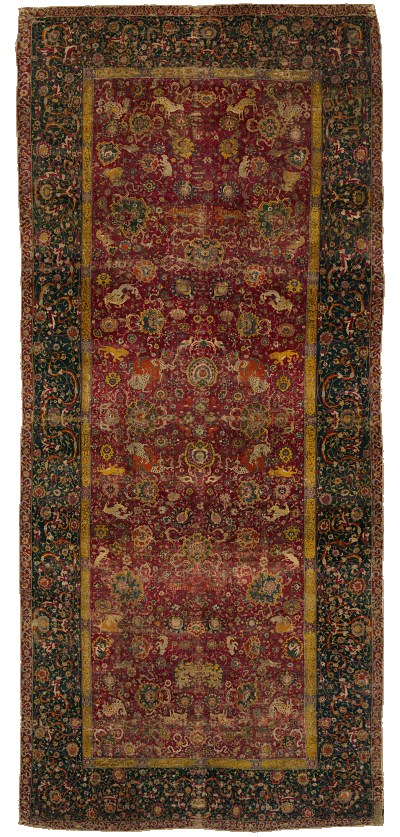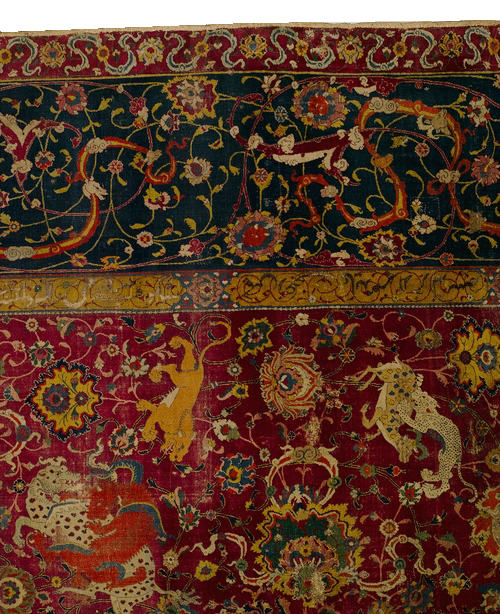|
METROPOLITAN MUSEUM TO OPEN
RENOVATED ISLAMIC GALLERIES
The celebrated Emperor's Carpet, a16th Century Persian (Safavid)
piece, will be included in the new Islamic Wing.
NEW YORK – The grand reopening of a suite of 15 dramatic New Galleries for
the Art of the Arab Lands, Turkey, Iran, Central Asia, and Later South
Asia will take place at New York's Metropolitan Museum of Art on Nov. 1.
Included in the new Islamic wing are carpets from the 16th and 17th
centuries, including the recently restored, celebrated Emperor's Carpet, a
classical Persian (Safavid) carpet of the 16th century that was
presented to Hapsburg Emperor Leopold I by Peter the Great of Russia.
The renovated galleries will house the Metropolitan's renowned collection
of Islamic art. Design features within the new space will highlight both
the diversity and the interconnectedness of the numerous cultures.
"The opening of these extraordinary new galleries underscores our mission
as an encyclopedic museum and provides a unique opportunity to convey the
grandeur and complexity of Islamic art and culture at a pivotal moment in
world history," said Thomas P. Campbell, director of the Metropolitan
Museum.
"In sequence, the 15 new galleries trace the course of Islamic
civilization, over a span of 13 centuries, from the Middle East to North
Africa, Europe, and Central and South Asia. This new geographic
orientation signals a revised perspective on this important collection,
recognizing that the monumentality of Islam did not create a single,
monolithic artistic expression, but instead connected a vast geographic
expanse through centuries of change and cultural influence,"
The public will find galleries filled with art that evoke the plurality of
the Islamic tradition and the cross-fertilization of ideas and artistic
forms that has shaped the world's shared cultural heritage.
"Although our galleries represent a vast territory over a long period of
time, the diverse artworks shown here are nonetheless unified in several
distinctive ways. Primary among these is the extensive use of Arabic
script, which resulted in exceptional examples of calligraphy—often in
conventional media, such as metalwork or architectural elements—and
virtuosic achievements in the arts of the book,” said Sheila Canby, the
Patti Cadby Birch curator in charge of the Department of Islamic Art.
“There are many examples of luxury materials, due to royal patronage. And
technical expertise of the highest level is always evident, no matter what
the medium. Because the objects in our galleries are primarily secular in
nature, they can easily be appreciated both for their innate utility and
for their astonishing beauty, whatever the viewer's background may be."
The collection comprises more than 12,000 works of art drawn from an area
that extends from Spain in the west to India in the east. Some 1,200 works
of art in all media will be on view at any time, representing all major
regions and artistic styles, from the seventh century onward. Important
loans from the Hispanic Society of America will also be shown. (Displays
of textiles and works on paper will change frequently due to the
sensitivity of these materials to light.)
As part of the reinstallation of the galleries, a team of conservators and
scientists has engaged in an extensive program of conservation of the
major objects within the collection, from the Museum's extensive
collection of manuscripts to fragile glass objects and rare and precious
carpets.
In addition to the large collection of carpets, which have not been on
view to the public since the renovation began. other highlights of the
Museum's collection include the Damascus Room, built in 1707, and one of
the finest examples of Syrian homes of the wealthy during the Ottoman
period; glass, metalwork, and ceramics from Egypt, Syria, Iraq, and Iran;
notable early and medieval Qur'ans; pages from the sumptuous copy of the
Shahnama, or Book of Kings, created for Shah Tahmasp (1514–76) of Iran,
and royal miniatures from the courts of the Arab World, Ottoman Turkey,
Persia, and Mughal India, including paintings from the imperial "Shah
Jahan Album," compiled for the builder of the Taj Mahal; and architectural
elements including a 14th-century mihrab, or prayer niche, from Isfahan
decorated with glazed ceramic tiles, which would have served in a Muslim
house of worship to indicate the direction to Mecca.
To connect audiences of all ages with the collection in the galleries and
to enhance their understanding of the multiple perspectives and diversity
that exist within Islamic culture, a variety of educational initiatives
for families, students, teachers, and general visitors will be offered.
These include musical performances, hands-on workshops, lectures, films,
gallery talks, K-12 teacher workshops, an international symposium, panel
discussions, and conversations with artists, supplemented by publications
and online resources.
|

The Emperor's Carpet
16th century
Rogers Fund, 1943
43.121.1
Metropolitan Museum of Art, New York
 |

